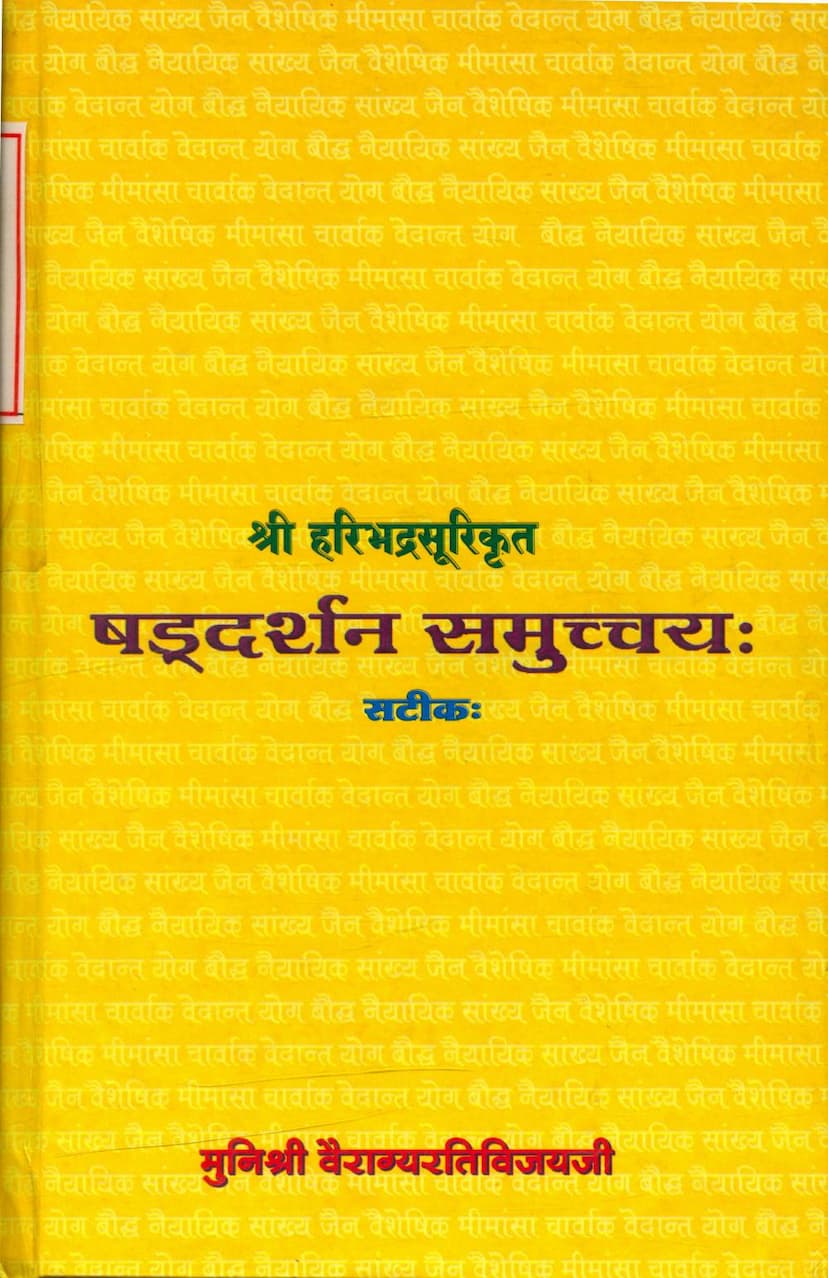Shaddarshan Samucchay
Added to library: September 2, 2025

Summary
Here's a comprehensive summary of the Jain text "Shaddarshan Samucchay" by Vairagyarativijay, based on the provided pages:
Book Title: Shaddarshan Samucchay (Collection of Six Philosophies) Author(s): Pujyapadacharya Shri Haribhadrasuri (primary), Pujyapadacharya Shri Rajashekhar Suri (secondary work included) Publisher: Pravachan Prakashan Commentary: Laghuvrutti by Pujyapadacharya Shri Somatilak Suri, Avachuri by an unknown author. Editor: Munivairagyaratvijay
Overview:
"Shaddarshan Samucchay" is a seminal work in Jain philosophy that aims to provide a concise overview and comparison of six prominent philosophical schools (Darshanas) prevalent in ancient India. The text's primary author, Acharya Haribhadrasuri, was a renowned scholar and philosopher who converted from Brahmanism to Jainism. His work is praised for its balanced, unbiased presentation of different viewpoints, making it an invaluable resource for understanding the philosophical landscape of the time. The text is further enriched by the commentaries and editions that have been developed over centuries.
Key Themes and Content:
The book is structured to introduce and explain the core tenets of six major philosophical traditions:
-
Baudha Darshanam (Buddhist Philosophy): Discusses the Buddhist concept of impermanence (Kshanikavada), the doctrine of no-self (Anatmavada), and the Four Noble Truths (Dukkha, Samudaya, Nirodha, Marga). It details the five aggregates (Skandhas) that constitute what is perceived as a self and explains the chain of dependent origination (Pratītyasamutpāda). The four main schools of Buddhism (Vaibhāṣika, Sautrāntika, Yogācāra, and Madhyamaka) are briefly touched upon, highlighting their differing views on the nature of external reality and consciousness.
-
Nyāya Darshanam (Nyaya Philosophy): Focuses on the logic and epistemology of Nyaya, founded by Acharya Gautama. It outlines the four valid means of knowledge (Pramānas): Pratyaksha (Perception), Anumāna (Inference), Upamāna (Comparison), and Shabda (Testimony). The text details the structure of valid inference (Hetu, Sādhya, Paksha, Vyāpti) and the logical fallacies (Hetvabhāsa). Nyaya's goal is liberation (Apavarga) through the removal of suffering caused by ignorance, achieved by understanding the nature of reality and the self.
-
Sāṅkhya Darshanam (Samkhya Philosophy): Presents Samkhya as a dualistic philosophy, founded by Acharya Kapila. It describes the interplay between Purusha (consciousness, the self) and Prakriti (primordial matter). Prakriti is characterized by three Gunas (Sattva, Rajas, Tamas), which, when out of balance, lead to the evolution of various categories like intellect (Buddhi), ego (Ahamkara), senses, and the five elements. Samkhya posits a plurality of Purushas and views liberation (Kaivalya) as the isolation of Purusha from Prakriti through discriminative knowledge (Viveka).
-
Jaina Darshanam (Jain Philosophy): This section is central to the work. It introduces the core Jain metaphysical principles, including the Six Existents (Dravyas): Jiva (soul), Ajiva (non-soul), Punya (merit), Papa (demerit), Asrava (inflow of karma), Samvara (cessation of karma), Bandha (bondage of karma), Nirjara (shedding of karma), and Moksha (liberation). It highlights the Jain emphasis on Syadvada (the doctrine of conditioned predication) and Naya (standpoints of interpretation) as crucial for understanding reality, which is described as possessing infinite properties (Anantadharmakātmaka). The text also touches upon the distinctions between Shvetambara and Digambara traditions.
-
Vaiśeṣika Darshanam (Vaishēṣika Philosophy): Founded by Acharya Kanada, this philosophy is closely allied with Nyaya. It focuses on the atomic theory of the universe and the classification of reality into seven categories (Padarthas): Dravya (Substance), Guna (Quality), Karma (Action), Sāmānya (Generality), Viśeṣa (Particularity), Samavāya (Inherence), and Abhāva (Non-existence). It explains the concept of atoms (Paramāṇu) and the creation of the world from their combinations.
-
Mimāṁsā Darshanam (Mimamsa Philosophy): Based on the Vedic injunctions, Mimamsa, primarily associated with Acharya Jaimini, focuses on the proper interpretation and performance of Vedic rituals (Karma Kanda). It considers the Vedas as eternal and authorless (Apaurusheya). The text outlines the six Pramanas accepted by Mimamsa (Pratyaksha, Anumana, Upamāna, Shabda, Arthāpatti, Anupalabdhi) and emphasizes the role of Dharma as the performance of Vedic duties without attachment to results for liberation.
-
Chārvāka Darshanam (Cārvāka Philosophy): Also known as Lokāyata, this school is characterized as materialistic and atheistic. The text notes its rejection of a soul, afterlife, God, and the validity of inference and testimony as sources of knowledge. Cārvāka accepts only direct perception (Pratyaksha) as a valid means of knowledge, asserting that consciousness arises from the combination of material elements. The text quotes from Cārvāka teachings that advocate for enjoying the present life and disregarding the unseen.
Commentaries and Editions:
- Laghuvrutti by Somatilak Suri: This is an important early commentary that clarifies the original text of Haribhadrasuri.
- Avachuri by Unknown Author: A shorter commentary providing a general explanation of the verses.
- Editorial Efforts: The current edition by Munivairagyaratvijay is based on valuable editorial work by respected scholars, aiming for accuracy and clarity.
- Inclusion of Rajashekhar Suri's Work: The volume also includes a portion of Rajashekhar Suri's "Shaddarshan Samucchay," which offers a different perspective and elaborates on certain aspects, particularly regarding the practices and symbols of different ascetic traditions.
Significance and Purpose:
The "Shaddarshan Samucchay" serves as an introductory text for those seeking to understand the various philosophical systems of ancient India. Acharya Haribhadrasuri's approach is commendable for its objective presentation, allowing readers to grasp the core doctrines of each school without bias. The included commentaries and later works enhance its value, providing deeper insights and context. The overall aim is to guide seekers towards right understanding and ultimately, liberation, by illuminating the paths offered by different philosophical traditions.